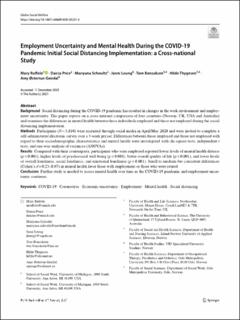| dc.contributor.author | Ruffolo, Mary | |
| dc.contributor.author | Price, Daicia | |
| dc.contributor.author | Schoultz, Mariyana | |
| dc.contributor.author | Leung, Janni | |
| dc.contributor.author | Bonsaksen, Tore | |
| dc.contributor.author | Thygesen, Hilde | |
| dc.contributor.author | Geirdal, Amy Østertun | |
| dc.date.accessioned | 2021-07-29T10:25:02Z | |
| dc.date.available | 2021-07-29T10:25:02Z | |
| dc.date.created | 2020-11-02T13:05:39Z | |
| dc.date.issued | 2021 | |
| dc.identifier.citation | Global Social Welfare. 2021, 8, 141–150. | en_US |
| dc.identifier.issn | 2196-8799 | |
| dc.identifier.uri | https://hdl.handle.net/11250/2765598 | |
| dc.description | This article is licensed under a Creative Commons Attribution 4.0 International License, which permits use, sharing, adaptation, distribution and reproduction in any medium or format, as long as you give appropriate credit to the original author(s) and the source, provide a link to the Creative Commons licence, and indicate if changes were made. The images or other third party material in this article are included in the article's Creative Commons licence, unless indicated otherwise in a credit line to the material. If material is not included in the article's Creative Commons licence and your intended use is not permitted by statutory regulation or exceeds the permitted use, you will need to obtain permission directly from the copyright holder. | en_US |
| dc.description.abstract | Background
Social distancing during the COVID-19 pandemic has resulted in changes in the work environment and employment uncertainty. This paper reports on a cross-national comparison of four countries (Norway, UK, USA and Australia) and examines the differences in mental health between those individuals employed and those not employed during the social distancing implementation.
Methods
Participants (N = 3,810) were recruited through social media in April/May 2020 and were invited to complete a self-administered electronic survey over a 3-week period. Differences between those employed and those not employed with regard to their sociodemographic characteristics and mental health were investigated with chi-square tests, independent t tests, and one-way analysis of variances (ANOVAs).
Results
Compared with their counterparts, participants who were employed reported lower levels of mental health distress (p < 0.001), higher levels of psychosocial well-being (p < 0.001), better overall quality of life (p < 0.001), and lower levels of overall loneliness, social loneliness, and emotional loneliness (p < 0.001). Small to medium but consistent differences (Cohen’s d = 0.23–0.67) in mental health favor those with employment or those who were retired.
Conclusion
Further study is needed to assess mental health over time as the COVID-19 pandemic and employment uncertainty continues. | en_US |
| dc.language.iso | eng | en_US |
| dc.rights | Navngivelse 4.0 Internasjonal | * |
| dc.rights.uri | http://creativecommons.org/licenses/by/4.0/deed.no | * |
| dc.title | Employment Uncertainty and Mental Health during the COVID-19 Pandemic Initial Social Distancing Implementation: A Cross-national study | en_US |
| dc.type | Peer reviewed | en_US |
| dc.type | Journal article | en_US |
| dc.description.version | publishedVersion | en_US |
| dc.rights.holder | © The Author(s) 2021 | en_US |
| dc.source.pagenumber | 141–150 | en_US |
| dc.source.volume | 8 | en_US |
| dc.source.journal | Global Social Welfare | en_US |
| dc.identifier.doi | 10.1007/s40609-020-00201-4 | |
| dc.identifier.cristin | 1844116 | |
| cristin.ispublished | true | |
| cristin.fulltext | original | |
| cristin.qualitycode | 1 | |

